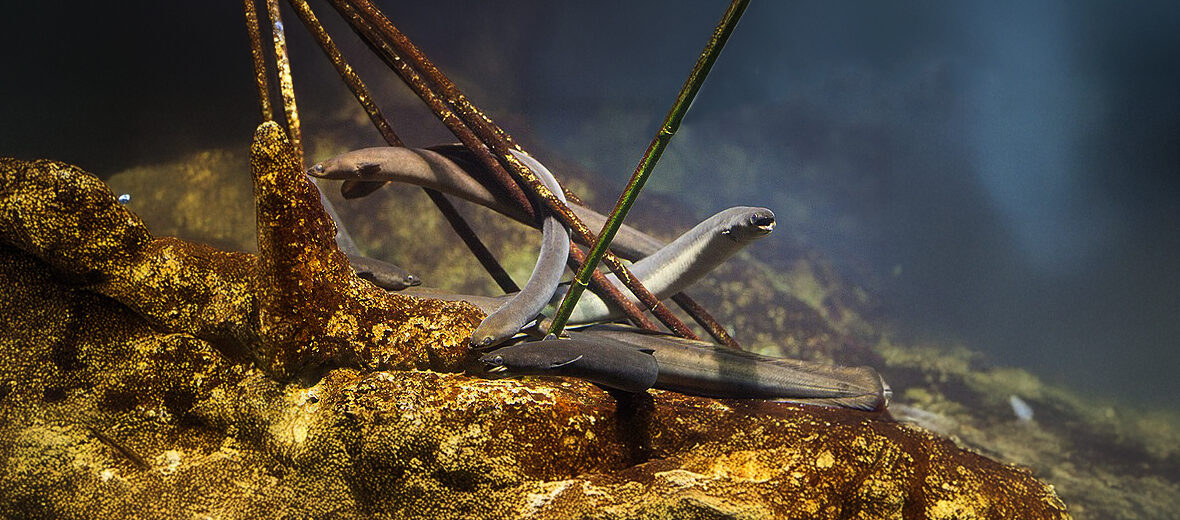
The European eel was cloaked in mystery for thousands of years. Their mating habits are still a mystery. These critters have a wide range but a shrinking population. European eels face numerous threats to their survival such as habitat loss and destruction at the hands of residential and commercial development, dams, farming, ranching, oil and gas mining, and logging; shipping lanes that can result in vehicle strike (being hit by vehicles); overfishing; overharvesting; invasive species, that can bring about disease and predation; parasites; land pollution; air pollution; water pollution; and microplastics pollution; and climate change, that can cause habitat shifting and alteration, storms, flooding, and droughts. The IUCN lists these eels as Critically Endangered. Their population trend is listed as decreasing.
First the Stats…
Scientific name: Anguilla anguilla
Weight: Up to 14.55 lbs.
Length: Up to 4.4 feet
Lifespan: Up to 80+ years
Now on to the Facts!
1.) These eels undergo 5 stages of development during their lifecycle: larva, glass eel, elver, yellow eel, and silver eel.
2.) There was 1 specimen known as “the Brantevik Eel” that lived for 155 years in the well of a family home in Brantevik, a fishing village located in southern Sweden.
3.) They can dwell at depths of up to 2,297 feet.
4.) After they spawn in the Sargasso Sea, they head northwards throughout the Atlantic Ocean, as well as its coastlines, and the rivers that empty into it.
5.) These eels are nocturnal (active at night).
But wait, there’s more on the European eel!
6.) Worms, various fish (even fish too large to eat without biting off chunks), slugs, crayfish, and occasionally plankton (when smaller juveniles) are all on the menu.
7.) Larger eels (including adult European eels), herons, cormorants, pike, and seagulls all prey on these eels.
Did you know…?
Over an 80 year period, waters possessing large dams have displayed nearly twice the reduction of eel numbers as waters without dams.
8.) Shelter is taken amongst plants, rock crevices, and even in muddy fields (when venturing inland).
9.) Their numbers have been thought to have declined by around up to 98% since the 1970s!
10.) They are also affected by parasites such as Anguillicola crassus.
But wait, there’s still more on the European eel!
11.) Glass-eel fishing using basket traps has been of great economic value in many river estuaries along the western seaboard of Europe.
12.) In an effort to make eel consumption more sustainable, in 2010, Greenpeace International added the European eel to its “seafood red list”, and the Sustainable Eel Group also launched the Sustainable Eel Standard.
Did you know…?
The United States imports up to 11 million lbs. of eel every year to support its sushi industry, and European eels are among those imported.
13.) As this eel’s population has been declining for quite some time, numerous projects have been initiated. In 1997, Innovatie Netwerk in the Netherlands began a project in which they attempted to get these eels to breed in captivity by using a swimming machine to simulate the 4,000 mile journey from Europe to the Sargasso Sea.
14.) Unlike most other migratory fish, these eels begin their life cycle in the ocean, spending most of their lives in fresh inland water, or brackish coastal water before returning to the ocean to spawn and then die.
15.) Their migration from the Sargasso Sea inland takes upwards of 300 days.
But wait, there’s still a little more on the European eel!
16.) Often times these eels will never enter freshwater, instead choosing to remain in a marine environment throughout their life. Others grow up in brackish water, or migrate between saltwater, brackish water, and freshwater numerous times during their lifetime.
17.) Magnetoreception (a sense which allows an organism to detect the Earth’s magnetic field) has also been reported to be used by the European eel in at least 1 study, and may be utilized for navigation.
Did you know…?
Eel aquaculture is most prevalent in Japan, however China, Scandinavia, Europe, Australia, Morocco, and Taiwan also engage in this practice.
18.) The eel farming industry utilizes recirculating pools to rear glass eels taken from the wild for 8 months to 2 years until they’re mature enough for sale.
19.) Valliculture (exploiting the natural migrations of fish from the sea into coastal lagoons by strategically controlling water flow and creating enclosed areas to trap and raise them) along the coasts through the use of weirs (low dam built across a river to raise the level of water upstream or regulate its flow) is also used rather than recirculating pools for eel farming.
20.) Even though the exportation of these eels has been restricted since 2010, an average 44% of eel sales in the United States consist of European eels.
21.) European eels lay up to 10,000,000 eggs each year!
Now a Short European Eel Video!
Be sure to share & comment below! Also, check out the Critter Science YouTube channel. Videos added regularly!

Want to suggest a critter for me to write about? Let me know here.
Some source material acquired from: Wikipedia & IUCN
Photo credit: Dmitriy Konstantinov



